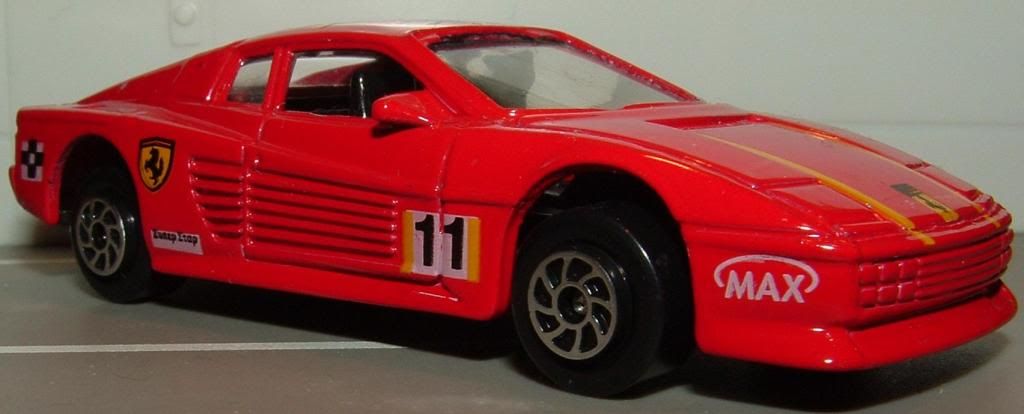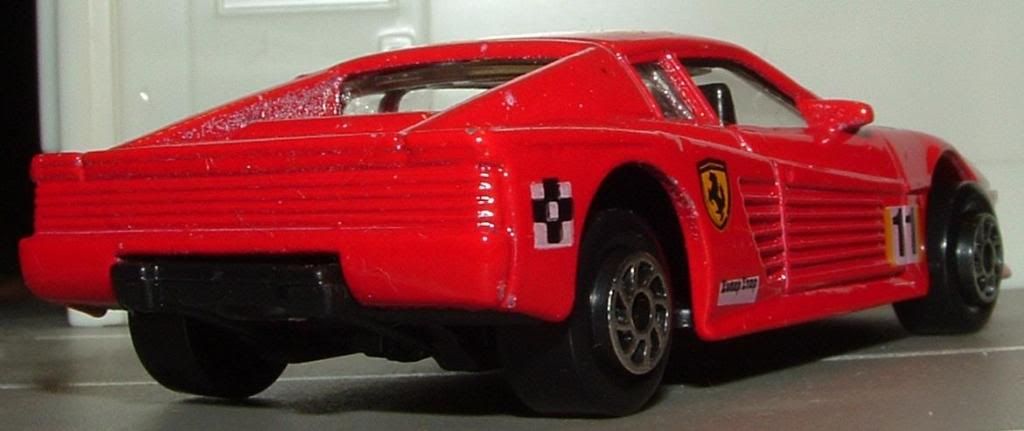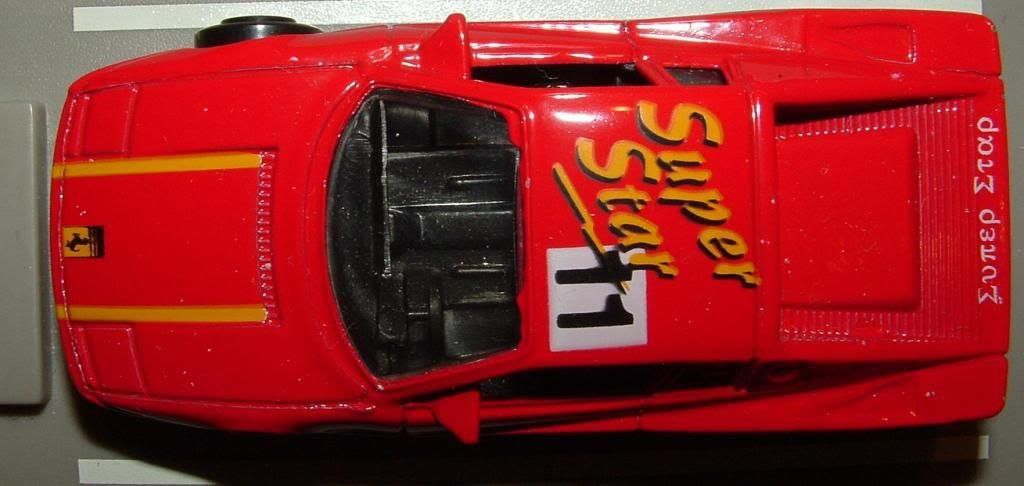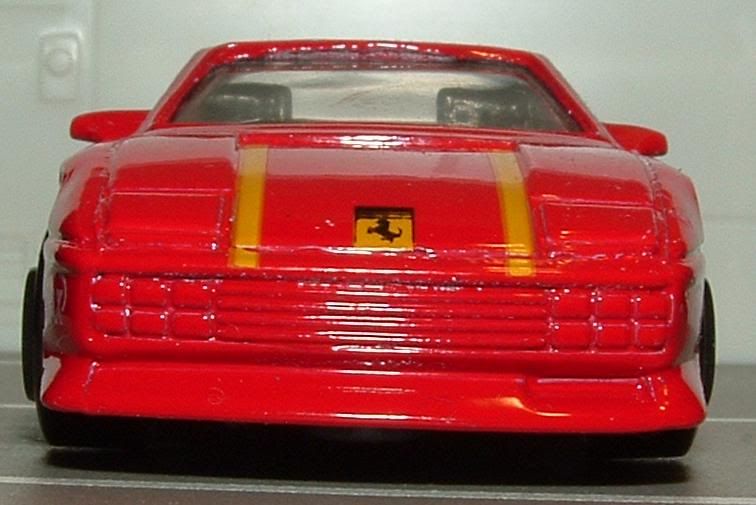
A blog focusing on 1/64 diecast from such popular brands as Hot Wheels, Matchbox, Johnny Lightning, M2 Machines, GreenLight, Tomica, Yat Ming, Majorette, MotorMax, Siku, Corgi, Guisval, Playart, Ertl, Zylmex, Racing Champions, & many more. Swifty's Garage features a daily Car Of The Day and news updates from your favorite brands!
Tuesday, March 15, 2011
Car Of The Day: March 15, 2011
Today's car of the day is Yat Ming's 1985 Ferrari Testarossa.
The Ferrari Testarossa is a 12-cylinder mid-engine sports car manufactured by Ferrari, which went into production in 1984 as the successor to the Ferrari Berlinetta Boxer. The Pininfarina-designed car was originally produced from 1984 to 1991, with two model revisions following the ending of Testarossa production and the introduction of the 512 TR and F512 M which were produced from 1992 to 1996. Almost 10,000 Testarossas, 512 TRs, and F512 Ms were produced, making it one of the most common Ferrari models, despite its high price and exotic design. In 1995, the F512 M retailed for $220,000. The word Testarossa is Italian for "redhead".
The Testarossa is a two-door coupe with a fixed roof that premiered at the 1984 Paris Auto Show.[4] All versions of the Testarossa had the power fed through the wheels from a rear-mounted, five-speed manual transmission. The Rear mid-engine, rear-wheel drive layout (engine between the axles but behind the cabin) keeps the centre of gravity in the middle of the car, which increases stability and improves the car's cornering ability, and thus results in a standing weight distribution of 40% front: 60% rear. The original Testarossa was re-engineered for 1992 and released as the 512 TR, at the Los Angeles Auto Show, effectively as a completely new car, and an improved weight distribution of 41% front: 59% rear. The F512 M was introduced at the 1994 Paris Auto Show. The car dropped the TR initials and added the M which in Italian stood for modificata, or translated to modified, and was the final version of the Testarossa, and continued its predecessor's weight distribution improvement of 42% front: 58% rear. The F512 M was Ferrari's last mid-engine 12-cylinder car, apart from the F50 and Ferrari Enzo, featuring the company's last flat engine. The Testarossa was replaced in 1996 by the front-engined 550 Maranello coupe.
The vehicle should not be confused with the Ferrari TR "Testa Rossa" of the late 1950s and early 1960s, which were GT sports cars that ran in the World Sportscar Championship, including the 24 Hours of Le Mans.
For more information and pictures of the real car please visit: Ferrari Testarossa
The Yat Ming is a nice representation of the classic Testarossa. Growing up in the '80s this is one of the first two models to jump to my mind when I hear the word 'Ferrari' (the other is the 308 GTS targa). The Testarossa debuted in an era before Hot Wheels had an exclusive on the Ferrari license and as such was a very popular subject in miniature. Examples of this vehicle were made by almost every major diecast manufacturer doing business in the 1980s and a few others since then.
The Testarossa can trace its roots back to the faults of the 1981 512i BB. The problems that the Testarossa was conceived to fix, included a cabin that got increasingly hot from the indoor plumbing that ran between the front-mounted radiator and the midships-mounted engine and a lack of luggage space. To fix these problems Ferrari and Pininfarina designed the Testarossa to be larger than its predecessor, the Berlinetta Boxer. For instance, at 1,976 millimetres (78 in) wide the Testarossa was half a foot wider than the Boxer. This resulted in an increased wheelbase that stretched about 64 mm (2.5 in) to 2,550 mm (100 in) which was used to accommodate luggage in a carpeted storage space under the front forward-opening hood. The increase in length created extra storage space behind the seats in the cabin. Headroom was also increased with a roofline half an inch taller than the Boxer.
Pininfarina's body was a departure from the curvaceous boxer -- one which caused some controversy. The side strakes sometimes referred to as "cheese graters" or "egg slicers," that spanned from the doors to the rear fenders were needed for rules in several countries outlawing large openings on cars. The Testarossa had twin radiators in the back with the engine instead of a single radiator up-front. In conjunction the strakes provided cool air to the rear-mounted side radiators, thus keeping the engine from overheating. The strakes also made the Testarossa wider at the rear than in the front, thus increasing stability and handling.
One last unique addition to the new design was a single high mounted rear view mirror on the driver's side. On US based cars, the mirror was lowered to a more normal placement in 1987 and quickly joined by a passenger side rear view mirror for the driver to be able to make safe easy lane changes.
Like its predecessor, the Testarossa used double wishbone front and rear suspension systems. Ferrari improved traction by adding 10-inch-wide alloy rear wheels. The Testarossa drivetrain was also an evolution of the BB 512i. Its engine used near identical displacement and compression ratio, but unlike the BB 512i had four-valve cylinder heads that were finished in red.
Subscribe to:
Post Comments (Atom)






No comments:
Post a Comment